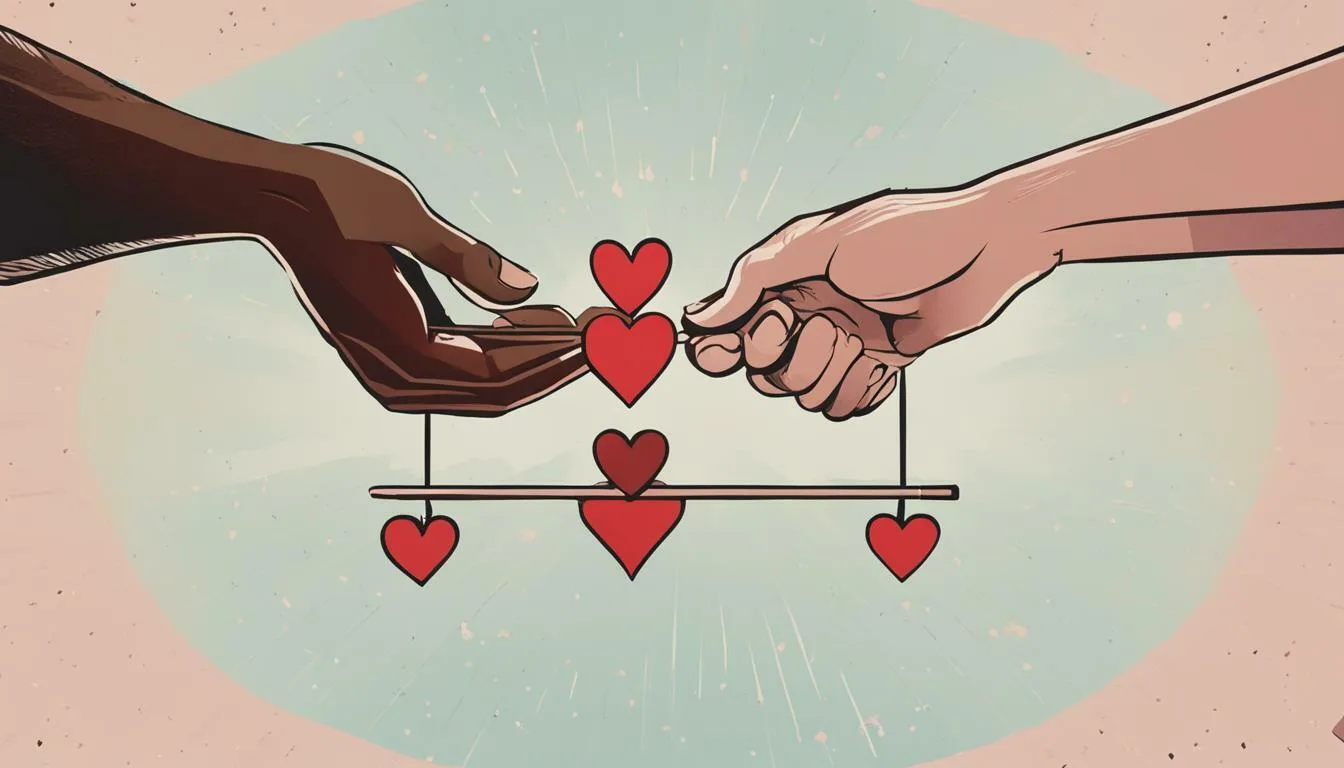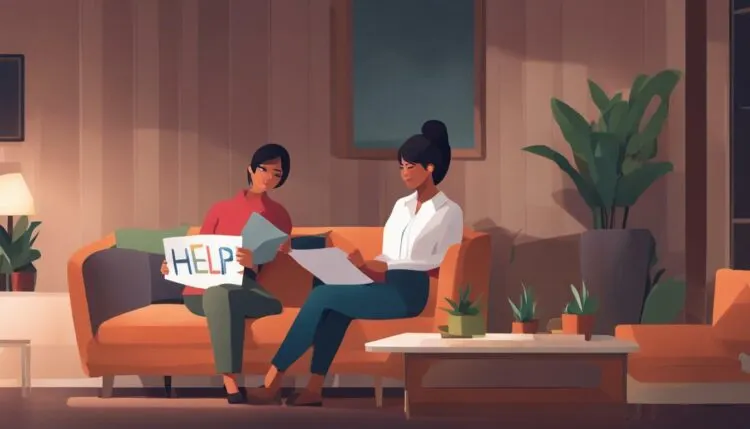Understanding relationship dynamics is key to building strong and healthy connections with others. Relationship dynamics refer to the patterns of behavior between partners, including how they communicate, handle conflict, and support each other.
These dynamics can either strengthen a relationship or create challenges that need to be addressed.
In healthy relationships, partners communicate openly, respect each other’s boundaries, and show empathy. They work together to solve problems and support each other’s growth.
However, not all relationships have healthy dynamics. Sometimes, unhealthy patterns like fear and shame, demand and withdrawal, or the distancer and pursuer dynamic can develop.
These issues can lead to misunderstandings, frustration, and emotional pain.
It’s important to recognize the signs of both healthy and unhealthy relationship dynamics. By understanding these patterns, you can work towards improving your relationship and creating a more supportive and loving environment.
In this article, we’ll explore different types of relationship dynamics, common challenges, and practical tips for fostering healthy patterns.
Whether you’re trying to strengthen your current relationship or prepare for future ones, knowing about relationship dynamics can help you build better, more fulfilling connections.

What Are Relationship Dynamics?
Relationship dynamics are the patterns of behavior between people in a relationship.
These patterns can be positive or negative, shaping how we interact with each other. Healthy relationship dynamics include:
- Good communication
- Mutual respect
- Trust
- Support
When we talk openly and listen to each other, it helps build a strong connection.
Respecting each other’s opinions and boundaries also keeps the relationship balanced and fair. Trust is essential, as it allows us to feel safe and secure with our partner. Supporting each other through tough times strengthens the bond and shows we care.
On the other hand, unhealthy relationship dynamics can cause problems.
Poor communication, like not listening or constantly interrupting, leads to misunderstandings and conflicts. Disrespect, such as name-calling or belittling, damages self-esteem and creates resentment. Lack of trust can make us feel insecure and anxious, always doubting our partner’s intentions.
When one person tries to control or manipulate the other, it creates an imbalance of power and makes the relationship toxic. This can include jealousy, possessiveness, or guilt-tripping.
Recognizing these dynamics helps us understand what makes a relationship work well or fall apart.
By focusing on healthy patterns and addressing common issues, we can improve our relationships and create a more positive and supportive environment for everyone involved.
What Are Some Different Relationship Dynamics?
Different relationship dynamics can greatly affect how partners interact. Here are some common ones:
| Type of Dynamic | Description |
|---|---|
| Healthy Communication | Partners talk openly and listen to each other. |
| Mutual Respect | Both respect each other’s opinions and boundaries. |
| Trust and Honesty | Partners trust each other and are honest. |
| Supportive | Partners support each other through tough times. |
| Controlling | One partner tries to control or dominate the other. |
| Dependent | One partner relies too much on the other for emotional support. |
| Jealous and Possessive | One partner is overly jealous and possessive. |
| Conflict-Avoidant | Partners avoid addressing issues, leading to unresolved conflicts. |
| Criticism and Defensiveness | Partners frequently criticize each other and become defensive. |
| Codependent | Both partners are overly dependent on each other, losing individuality. |
In a healthy communication dynamic, partners share their thoughts and feelings openly. They respect each other’s opinions and boundaries, building a trusting and honest relationship. Support is also key, helping each other through challenges.
Controlling dynamics are unhealthy, where one partner tries to dominate.
Dependency can be problematic if one relies too much on the other for emotional needs. Jealousy and possessiveness create insecurity and tension.
Conflict-avoidant dynamics mean partners avoid discussing problems, leading to bigger issues later. Constant criticism and defensiveness can damage self-esteem and trust. Codependent relationships cause partners to lose their sense of self, relying too much on each other.
Understanding these dynamics helps us recognize what works and what doesn’t in relationships, allowing us to foster healthier interactions.

What Are Unhealthy Relationship Dynamics?
Unhealthy relationship dynamics can create stress and harm.
These patterns include manipulation, where one partner controls the other, and lack of communication, leading to unresolved issues. Blame games, where partners always blame each other, create conflict. Passive-aggressive behavior causes confusion and resentment.
Jealousy and possessiveness can make one feel trapped. These dynamics prevent a relationship from being supportive and loving.
Let’s review some of the biggest offenders in greater detail.
Fear and Shame
Fear and shame in a relationship make you feel unsafe and unworthy.
If your partner uses fear to control you, it creates constant anxiety. Shame makes you feel bad about yourself, as if you can’t do anything right. This can happen through criticism, insults, or making you feel guilty. Living in fear and shame destroys your confidence and happiness.
It stops you from being yourself and enjoying a healthy, supportive relationship. These dynamics are harmful and need to be addressed.
Demand and Withdrawal
Demand and withdrawal create a toxic cycle.
One partner makes constant demands for attention, validation, or change. The other partner responds by withdrawing, avoiding confrontation and emotional engagement.
This dynamic leads to frustration and resentment. The demanding partner feels ignored and unappreciated, while the withdrawing partner feels overwhelmed and attacked. This cycle prevents healthy communication and intimacy, making it hard to solve problems and grow together.
Addressing these behaviors is key to improving the relationship.
Distancer and Pursuer
In a distancer and pursuer dynamic, one partner seeks closeness while the other pulls away.
The pursuer tries to get closer, asking for more time and attention. The distancer, feeling overwhelmed, retreats further, creating more distance.
This pattern leads to frustration and conflict, as the pursuer feels rejected and the distancer feels smothered.
It prevents healthy communication and connection, making it hard to meet each other’s needs. Breaking this cycle involves both partners working to balance their need for space and intimacy.
Co-Dependency
Co-dependency in a relationship means one partner relies too much on the other for emotional support and validation.
This often leads to neglecting personal needs and interests. Both partners may lose their sense of individuality, making it hard to function independently.
It creates an unhealthy balance where one person might feel overwhelmed by the constant neediness, while the other feels empty without their partner’s constant reassurance.
This dynamic prevents both from growing and maintaining a healthy, balanced relationship.
Power Imbalances and Societal Norms
Power imbalances and societal norms can create unhealthy dynamics in relationships.
When one partner holds more power, whether through finances, decision-making, or social status, it can lead to control and manipulation.
Societal norms, like traditional gender roles, can also contribute to these imbalances, making one partner feel inferior or submissive. This dynamic prevents equality and mutual respect, causing resentment and dissatisfaction.
Both partners should strive for a balanced relationship where decisions and responsibilities are shared equally, ensuring fairness and respect.

What Are the Biggest Challenges With Relationship Dynamics?
The biggest challenges with relationship dynamics often stem from poor communication and unmet needs.
When partners don’t communicate well, misunderstandings and conflicts arise. Miscommunication can lead to assumptions and hurt feelings. It’s hard to resolve issues if you’re not on the same page.
Another challenge is balancing individuality and togetherness. It’s important to maintain your own identity while being part of a couple. If one person feels smothered or the other feels neglected, it can cause tension.
Trust issues are also a major challenge.
Without trust, it’s hard to feel secure and connected. Past betrayals or insecurities can make it difficult to fully trust your partner. This lack of trust can lead to jealousy and controlling behavior, which further damages the relationship.
Managing expectations is another hurdle.
Each person comes into a relationship with their own set of expectations about how things should be. When these expectations aren’t met, it can cause disappointment and resentment. It’s important to communicate openly about your needs and find a compromise that works for both partners.
Finally, dealing with external stressors like work, family, or financial problems can strain a relationship. Stress can make people irritable and less patient, leading to more arguments.
It’s crucial to support each other and find healthy ways to cope with stress together.

What Is the Ideal Relationship Dynamic?
The ideal relationship dynamic is built on trust, respect, and good communication.
Both partners should feel safe to share their thoughts and feelings without fear of judgment. This open communication helps prevent misunderstandings and resolves conflicts quickly.
Mutual respect is crucial.
Both people should value each other’s opinions and boundaries. This means listening when the other person speaks and not belittling their feelings. Respecting each other creates a strong foundation for the relationship.
Trust is another key element.
Trust allows both partners to feel secure and confident in the relationship. It means being honest and reliable. When trust is present, it reduces jealousy and insecurity, making the relationship stronger.
Support and understanding are also important.
Each partner should support the other through good and bad times. This includes celebrating successes together and being there during tough times. Understanding each other’s needs and feelings helps build a deeper connection.
Equality in the relationship is essential.
Both partners should share responsibilities and make decisions together. This balance ensures that one person doesn’t feel overwhelmed or taken for granted.
Lastly, maintaining individuality while being part of a couple is important.
Both partners should have their own interests and friends. This helps keep the relationship fresh and prevents feelings of suffocation.
By focusing on these elements, couples can create a healthy and fulfilling relationship dynamic.
How to Change Relationship Dynamics
Changing relationship dynamics starts with open communication.
Talk honestly about what’s not working and listen to each other’s feelings. Identify specific behaviors that need to change and agree on steps to improve them.
Be patient and supportive as you both work on these changes. It’s important to practice empathy and understanding, recognizing that change takes time. Seeking help from a counselor can also be beneficial. By committing to these steps, you can create a healthier and more supportive relationship.
Now let’s review the most crucial steps in greater detail:
Get Back to Being Kind
Start by showing kindness to each other daily.
Simple acts like saying “please” and “thank you” can make a big difference. Compliment each other and express appreciation for the little things.
When conflicts arise, approach them with a gentle tone and avoid harsh words. Remember to be patient and understanding. Doing small, thoughtful gestures can help rebuild a positive atmosphere.
By focusing on kindness, you create a more loving and supportive environment, making it easier to work through issues together.
Communicate Your Needs
Communicate your needs clearly and respectfully.
Let your partner know what you need from the relationship without blaming or criticizing them. Use “I” statements like “I feel lonely when we don’t spend time together.”
This helps your partner understand your perspective without feeling attacked. Be specific about what you need, whether it’s more quality time, help with chores, or emotional support. Listening to your partner’s needs is also important.
Open and honest communication can help both of you feel heard and valued, improving the relationship dynamic.
Strategies for better communication:
- Clearly state your needs and limits.
- Be firm but respectful when discussing boundaries.
- Use “I” statements to explain how you feel.
- Listen to your partner’s boundaries and respect them.
- Agree on mutual boundaries and stick to them.
- Communicate any changes in boundaries immediately.
- Revisit and adjust boundaries as needed.
- Be consistent in enforcing your boundaries.
These steps help ensure both partners feel respected and secure, creating a healthier and more balanced relationship.
Practice Empathy
Practice empathy by trying to understand your partner’s feelings and perspectives.
Put yourself in their shoes and consider how they might feel in different situations. When they talk, listen carefully without interrupting.
Show that you care about their emotions by responding with kindness and concern.
For example, if they’re upset, say, “I understand why you feel that way.” This helps create a stronger emotional connection and shows your partner that you value their feelings.
Practicing empathy can improve communication and make your relationship more supportive and loving.
Set and Enforce Healthy Boundaries
Set and enforce healthy boundaries by clearly stating what you need and expect in the relationship.
For example, let your partner know if you need personal space or time alone. Be firm but respectful when discussing these boundaries. It’s important to stick to them, even if it’s tough.
Enforcing boundaries helps both partners feel safe and respected. It prevents misunderstandings and conflicts, ensuring that both of you know each other’s limits.
By maintaining these boundaries, you create a more balanced and respectful relationship.
Strategies for setting healthy boundaries:
- Clearly state your needs and limits.
- Be firm but respectful when discussing boundaries.
- Use “I” statements to explain how you feel.
- Listen to your partner’s boundaries and respect them.
- Agree on mutual boundaries and stick to them.
- Communicate any changes in boundaries immediately.
- Revisit and adjust boundaries as needed.
- Be consistent in enforcing your boundaries.
These steps ensure both partners feel respected and secure, creating a healthier and more balanced relationship.
Argue Without Criticism or Contempt
When you argue, avoid criticism and contempt.
Dr. John Gottman identifies these as two of the “Four Horsemen” destructive behaviors that can lead to divorce. Instead of attacking your partner’s character, focus on the issue. Use “I” statements, like “I feel upset when…” to express your feelings without blaming.
Avoid name-calling, sarcasm, or mocking. Show respect and listen to your partner’s perspective. This approach helps prevent escalation and keeps the argument constructive, fostering a healthier relationship dynamic.
Strategies for resolving conflict:
- Stay calm and take deep breaths.
- Listen to your partner’s point of view without interrupting.
- Use “I” statements to express your feelings.
- Avoid blame and focus on finding a solution.
- Take breaks if the argument gets too heated.
- Agree to compromise and find middle ground.
- Apologize if you’re wrong and forgive your partner.
- Work together to prevent future conflicts.
These steps help create a respectful and constructive way to resolve disagreements.

How Do You Balance Dynamics in a Relationship?
Balancing dynamics in a relationship requires effort from both partners.
Start by sharing responsibilities equally. Whether it’s household chores, finances, or making decisions, both should contribute. This prevents one person from feeling overwhelmed or taken for granted.
Communication is key. Regularly check in with each other to discuss how you’re feeling and address any issues. This helps catch problems early before they become bigger issues. Make sure to listen actively when your partner speaks and show empathy.
Respect each other’s individuality.
It’s important to have your own hobbies, friends, and interests. Encourage your partner to pursue their passions, and take time for yours as well. This keeps the relationship fresh and prevents feelings of suffocation.
Set and respect boundaries. Understand what each other’s limits are and stick to them. This includes personal space and time alone. Clear boundaries help maintain a healthy balance between togetherness and independence.
Support each other. Be there for your partner during tough times and celebrate their successes. This strengthens your bond and shows that you value each other.
Finally, compromise is essential. You won’t always agree on everything, and that’s okay. Find middle ground that works for both of you. By compromising, you show that you’re willing to put the relationship first.
By following these steps, you can create a balanced, healthy relationship dynamic that works for both partners.
Final Thoughts
He makes you doubt your own memories and feelings.
When you bring up concerns, he says you’re overreacting or imagining things. This confuses you and makes you question your reality. Over time, you feel like you can’t trust your own mind. He uses this tactic to avoid taking responsibility and to control the situation.
You end up feeling insecure and dependent on his version of events. This manipulation keeps you from seeing the truth and addressing real issues in the relationship.
Frequently Asked Questions
What role does emotional intelligence play in relationship dynamics?
Emotional intelligence plays a big role in relationship dynamics.
It helps us understand and manage our own emotions and recognize the emotions of our partner. With good emotional intelligence, we can communicate better, resolve conflicts more effectively, and show empathy.
This means we can respond calmly during arguments and support our partner when they’re upset.
It also helps us build trust and respect by being aware of how our actions affect each other. Overall, emotional intelligence leads to healthier, more balanced relationships by promoting understanding and connection.
Do external factors impact relationship dynamics?
Yes, external factors impact relationship dynamics.
Stress from work, financial problems, and family issues can strain a relationship. These pressures can make partners more irritable and less patient.
Social influences, like friends and cultural expectations, also play a role. For example, if friends or family disapprove of the relationship, it can create tension.
Big life changes, like moving or having a baby, can also affect how partners interact.
Being aware of these factors helps couples address them together, maintaining a healthy balance and supporting each other through challenges.
How does a long-distance relationship affect relationship dynamics?
A long-distance relationship affects dynamics by challenging communication and trust.
Without regular face-to-face time, partners must rely on calls and messages to stay connected. This can lead to misunderstandings and feelings of loneliness.
Trust becomes crucial, as physical distance can create doubts and insecurities.
Planning visits and maintaining regular communication are key. Long-distance can also make small conflicts feel bigger due to limited interaction.
However, it can strengthen bonds if both partners are committed and make an effort to show care and support despite the distance.
How do non-monogamous relationships impact the dynamics of the relationship?
Non-monogamous relationships impact dynamics by requiring strong communication and trust among all partners.
Clear boundaries and agreements are essential to avoid jealousy and misunderstandings.
Each person must feel valued and respected. Time management becomes important to ensure everyone’s needs are met.
These relationships can enhance personal growth and connection if handled well. However, they can also lead to complications if communication breaks down or if partners are not honest about their feelings.
Overall, non-monogamous relationships demand high levels of openness and cooperation to maintain healthy dynamics.
When is professional help needed to improve relationship dynamics?
Professional help is needed when communication breaks down, conflicts escalate, or trust issues persist.
If you and your partner can’t resolve problems on your own, it’s time to seek help. Regain from BetterHelp is a great option for online therapy.
They offer flexible, convenient sessions with licensed therapists who can help improve your relationship dynamics. Therapy can provide new perspectives and tools to handle issues effectively.
BetterHelp/Regain is highly recommended for couples seeking to strengthen their relationship and work through challenges with professional support.
CLICK HERE to check them out on their website.














































